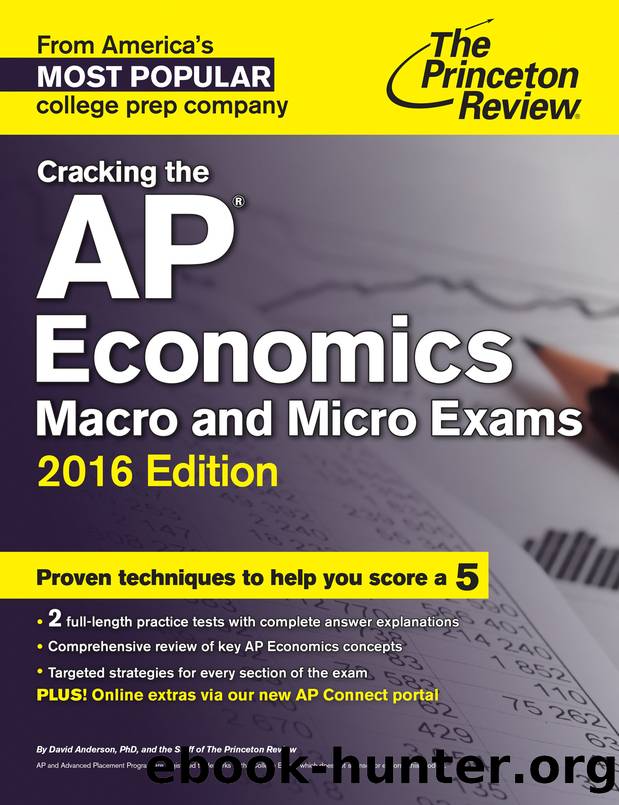Cracking the AP Economics Macro & Micro Exams, 2016 Edition by Princeton Review

Author:Princeton Review [Review, The Princeton]
Language: eng
Format: epub
ISBN: 978-0-8041-2645-8
Publisher: Random House Children's Books
Published: 2015-08-25T00:00:00+00:00
CHAPTER 8 REVIEW QUESTIONS
1. D
A competitive firmâs demand for labor is determined by that quantity when the marginal productivity of labor is equal to the marginal cost of labor (i.e., when the last worker produces just enough to cover his/her wages). Therefore the answer is (D).
2. E
A monopsony occurs when there is only one buyer for a specific good (for example, a large company in a small town is virtually the only buyer of labor). As the buyer is interested in maximizing its own revenue, the net result is that wages are depressed and fewer workers are hired (see Figure 4). Therefore the answer is (E).
3. C
Unions are interested in increasing their memberâs wages. They do this through collective bargaining, wage floors, featherbedding, increasing the demand for their goods (the âBuy Americanâ campaign, for example), and other such tactics. One way to approach this question is through Process of Elimination (which is probably the most efficient way as the tactics listed are all union tactics). Another is to realize that decreasing the price of substitute resources makes those resources more attractive and therefore would hurt union wages. Therefore the answer is (C).
4. A
Definition of a bilateral monopoly is when a monopsony buys from a monopoly (i.e., there is only one seller and one buyer of a good or service). See this page. Therefore the answer is (A).
5. C
Extracting proportionally more tax income from the poor is by definition a regressive tax. Therefore the answer is (C).
6. B
If the third workerâs MP = 10, then that worker generated income of 10 x $3 = $30. As the worker is paid $15, the firm is making economic profit. Therefore it should hire more workers until the productivity of the last worker just equals the revenue generated by that worker. Eliminate (C), (D) and (E). As more workers are hired (and no other investment in the business is made), each subsequent worker will generate lower and lower marginal revenue. Therefore the answer is (B).
7. E
As the question does not give any information on the profits the monopoly is making, one cannot comment on them, so eliminate (A), (B) and (C). Regulating a monopoly to allocative efficiency is a measure designed to reduce deadweight loss. Therefore the answer is (E).
8. A
When a firm produces at a point where MR = MC, then it is maximizing its profits (see pages this pageâthis page). Therefore the answer is (A).
9. C
As the demand curve does not change, answers focusing on demandâ(A) and (B)âcan be eliminated. A subsidy increases supply, so eliminate (E). Consumer surplus is the area under the demand curve between the equilibrium price and the vertical axis (see the figure below). The consumer surplus before the subsidy is the smaller triangle, and after the subsidy, consumer surplus increases. Therefore the answer is (C).
Download
This site does not store any files on its server. We only index and link to content provided by other sites. Please contact the content providers to delete copyright contents if any and email us, we'll remove relevant links or contents immediately.
Harry Potter: A Journey Through a History of Magic by British Library(369)
The Science of Philip Pullman's His Dark Materials by Mary Gribbin(344)
The Basics of Organic Chemistry by Clowes Martin;(342)
Harry Potter and the Sorcerer's Stone: SparkNotes Literature Guide by SparkNotes(305)
Flowers in the Gutter by K. R. Gaddy(274)
Braiding Sweetgrass for Young Adults by Robin Wall Kimmerer(267)
Super Simple Chemistry by D.K. Publishing(262)
Summary of the Selfish Gene by Readtrepreneur Publishing(260)
Exam Success in Geography for IGCSE & O Level by Unknown(258)
JavaScript Coding for Teens: A Beginner's Guide to Developing Websites and Games by Yueh Andrew(255)
Dark days in Salem: the witchcraft trials by Deborah Kent(246)
The Python Audio Cookbook;Recipes for Audio Scripting with Python by Alexandros Drymonitis(240)
Analysis and Linear Algebra for Finance: Part II by Bookboon.com(236)
Key Immigration Laws by Kathryn Ohnaka(231)
Cracking the AP Economics Macro & Micro Exams, 2017 Edition by Princeton Review(225)
Solutions for a Cleaner, Greener Planet: Environmental Chemistry by Marc Zimmer(216)
The Science of Fashion by Julie Danneberg;(212)
Reverse Engineering For Everyone! by mytechnotalent(204)
Cracking the AP Psychology Exam, 2017 Edition by Princeton Review(202)
